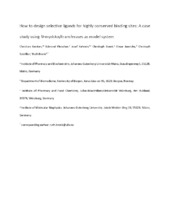| dc.contributor.author | Kersten, Christian | en_US |
| dc.contributor.author | Fleischer, Edmond | en_US |
| dc.contributor.author | Kehrein, Josef | en_US |
| dc.contributor.author | Borek, Christoph | en_US |
| dc.contributor.author | Jaenicke, Elmar | en_US |
| dc.contributor.author | Sotriffer, Christoph | en_US |
| dc.contributor.author | Brenk, Ruth | en_US |
| dc.date.accessioned | 2020-06-15T07:56:04Z | |
| dc.date.available | 2020-06-15T07:56:04Z | |
| dc.date.issued | 2020 | |
| dc.Published | Kersten C, Fleischer E, Kehrein J, Borek C, Jaenicke E, Sotriffer C, Brenk R. How To Design Selective Ligands for Highly Conserved Binding Sites: A Case Study Using N-Myristoyltransferases as a Model System. Journal of Medicinal Chemistry. 2020;63(5):2095–2113 | eng |
| dc.identifier.issn | 1520-4804 | |
| dc.identifier.issn | 0022-2623 | |
| dc.identifier.uri | https://hdl.handle.net/1956/22581 | |
| dc.description.abstract | A model system of two related enzymes with conserved binding sites, namely N-myristoyltransferase from two different organisms, was studied to decipher the driving forces that lead to selective inhibition in such cases. Using a combination of computational and experimental tools, two different selectivity-determining features were identified. For some ligands, a change in side-chain flexibility appears to be responsible for selective inhibition. Remarkably, this was observed for residues orienting their side chains away from the ligands. For other ligands, selectivity is caused by interfering with a water molecule that binds more strongly to the off-target than to the target. On the basis of this finding, a virtual screen for selective compounds was conducted, resulting in three hit compounds with the desired selectivity profile. This study delivers a guideline on how to assess selectivity-determining features in proteins with conserved binding sites and to translate this knowledge into the design of selective inhibitors. | en_US |
| dc.language.iso | eng | eng |
| dc.publisher | ACS | eng |
| dc.title | How To Design Selective Ligands for Highly Conserved Binding Sites: A Case Study Using N-Myristoyltransferases as a Model System | en_US |
| dc.type | Peer reviewed | |
| dc.type | Journal article | |
| dc.date.updated | 2019-11-08T16:33:09Z | |
| dc.description.version | acceptedVersion | en_US |
| dc.rights.holder | Copyright 2019 American Chemical Society | |
| dc.identifier.doi | https://doi.org/10.1021/acs.jmedchem.9b00586 | |
| dc.identifier.cristin | 1745529 | |
| dc.source.journal | Journal of Medicinal Chemistry | |
| dc.source.pagenumber | 2095–2113 | |
| dc.identifier.citation | Journal of Medicinal Chemistry. 2020;63(5):2095–2113 | |
| dc.source.volume | 63 | |
| dc.source.issue | 5 | |

